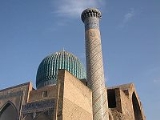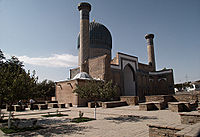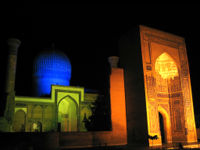
Gur-e Amir
Encyclopedia

Mausoleum
A mausoleum is an external free-standing building constructed as a monument enclosing the interment space or burial chamber of a deceased person or persons. A monument without the interment is a cenotaph. A mausoleum may be considered a type of tomb or the tomb may be considered to be within the...
of the Asia
Asia
Asia is the world's largest and most populous continent, located primarily in the eastern and northern hemispheres. It covers 8.7% of the Earth's total surface area and with approximately 3.879 billion people, it hosts 60% of the world's current human population...
n conqueror Tamerlane (also known as Timur
Timur
Timur , historically known as Tamerlane in English , was a 14th-century conqueror of West, South and Central Asia, and the founder of the Timurid dynasty in Central Asia, and great-great-grandfather of Babur, the founder of the Mughal Dynasty, which survived as the Mughal Empire in India until...
) in Samarkand
Samarkand
Although a Persian-speaking region, it was not united politically with Iran most of the times between the disintegration of the Seleucid Empire and the Arab conquest . In the 6th century it was within the domain of the Turkic kingdom of the Göktürks.At the start of the 8th century Samarkand came...
, Uzbekistan
Uzbekistan
Uzbekistan , officially the Republic of Uzbekistan is a doubly landlocked country in Central Asia and one of the six independent Turkic states. It shares borders with Kazakhstan to the west and to the north, Kyrgyzstan and Tajikistan to the east, and Afghanistan and Turkmenistan to the south....
. It occupies an important place in the history of Persian Architecture as the precursor and model for later great Mughal architecture
Mughal architecture
Mughal architecture, an amalgam of Islamic, Persian, Turkish and Indian architecture, is the distinctive style developed by the Mughals in the 16th, 17th and 18th centuries in what is now India, Pakistan, Bangladesh and Afghanistan. It is symmetrical and decorative in style.The Mughal dynasty was...
tombs, including Humayun's Tomb
Humayun's Tomb
Humayun's tomb is the tomb of the Mughal Emperor Humayun. The tomb was commissioned by Humayun's wife Hamida Banu Begum in 1562 AD, and designed by Mirak Mirza Ghiyath, a Persian architect...
in Delhi
Delhi
Delhi , officially National Capital Territory of Delhi , is the largest metropolis by area and the second-largest by population in India, next to Mumbai. It is the eighth largest metropolis in the world by population with 16,753,265 inhabitants in the Territory at the 2011 Census...
and the Taj Mahal
Taj Mahal
The Taj Mahal is a white Marble mausoleum located in Agra, India. It was built by Mughal emperor Shah Jahan in memory of his third wife, Mumtaz Mahal...
in Agra
Agra
Agra a.k.a. Akbarabad is a city on the banks of the river Yamuna in the northern state of Uttar Pradesh, India, west of state capital, Lucknow and south from national capital New Delhi. With a population of 1,686,976 , it is one of the most populous cities in Uttar Pradesh and the 19th most...
, built by Timur's descendants, the ruling Mughal dynasty
Mughal Empire
The Mughal Empire , or Mogul Empire in traditional English usage, was an imperial power from the Indian Subcontinent. The Mughal emperors were descendants of the Timurids...
of North India
India
India , officially the Republic of India , is a country in South Asia. It is the seventh-largest country by geographical area, the second-most populous country with over 1.2 billion people, and the most populous democracy in the world...
. It has been heavily restored.
Construction

Persian language
Persian is an Iranian language within the Indo-Iranian branch of the Indo-European languages. It is primarily spoken in Iran, Afghanistan, Tajikistan and countries which historically came under Persian influence...
for "Tomb of the King". This architectural complex with its azure dome contains the tombs of Tamerlane, his sons Shah Rukh and Miran Shah
Miran Shah
Miran Shah was a son of Timur, and a Timurid governor during his father's lifetime.Miran Shah's first charge was a vast region centered around Qandahar, which he was granted in 1383. That same year, he destroyed a rebellion against Timurid authority by the Kartids, then vassals of Timur in...
and grandsons Ulugh Beg
Ulugh Beg
Ulugh Bek was a Timurid ruler as well as an astronomer, mathematician and sultan. His commonly-known name is not truly a personal name, but rather a moniker, which can be loosely translated as "Great Ruler" or "Patriarch Ruler" and was the Turkic equivalent of Timur's Perso-Arabic title Amīr-e...
and Muhammad Sultan. Also honoured with a place in the tomb is Timur's teacher Sayyid Baraka
Sayyid Baraka
Sayyid Baraka was a holy man of the commercial city of Tirmidh, and spiritual teacher and friend to the 14th century warlord Timur. He was a fief of Andkhoy in Afghanistan, a town given to him by Timur. Timur is buried facing the Sayyid in the same mausoleum, Gur-e Amir, at Samarkand.-References:...
.
The earliest part of the complex was built at the end of the 14th century by the orders of Muhammad Sultan. Now only the foundations of the madrasah
Madrasah
Madrasah is the Arabic word for any type of educational institution, whether secular or religious...
and khanaka, the entrance portal and a part of one of four minaret
Minaret
A minaret مناره , sometimes مئذنه) is a distinctive architectural feature of Islamic mosques, generally a tall spire with an onion-shaped or conical crown, usually either free standing or taller than any associated support structure. The basic form of a minaret includes a base, shaft, and gallery....
s remains.
The construction of the mausoleum itself began in 1403 after the sudden death of Muhammad Sultan, Tamerlane's heir apparent and his beloved grandson, for whom it was intended. Timur had built himself a smaller tomb in Shahrisabz
Shahrisabz
Shakhrisabz , is a city in Uzbekistan located approximately 80 km south of Samarkand with the population of 53,000 . It is located at the altitude of 622 m. Once a major city of Central Asia, it is primarily known today as the birthplace of 14th century Turco-Mongol conqueror Timur...
near his Ak-Saray palace. However, when Timur died in 1405 on campaign on his military expedition to China
China
Chinese civilization may refer to:* China for more general discussion of the country.* Chinese culture* Greater China, the transnational community of ethnic Chinese.* History of China* Sinosphere, the area historically affected by Chinese culture...
, the passes to Shahrisabz were snowed in, so he was buried here instead. Ulugh Beg, another grandson of Tamerlane, completed the work. During his reign the mausoleum became the family crypt of the Timurid Dynasty
Timurid Dynasty
The Timurids , self-designated Gurkānī , were a Persianate, Central Asian Sunni Muslim dynasty of Turko-Mongol descent whose empire included the whole of Iran, modern Afghanistan, and modern Uzbekistan, as well as large parts of contemporary Pakistan, North India, Mesopotamia, Anatolia and the...
.
Architecture


During the reign of Ulugh Beg a doorway (see picture) was made to provide an entrance into the mausoleum.
Inwardly the mausoleum appears as a large, high chamber with deep niches at the sides and diverse decoration. The lower part of the walls covered are by onyx slabs composed as one panel. Each of these slabs is decorated with refined paintings. Above the panel there is a marble stalactite cornice. Large expanses of the walls are decorated with painted plaster; the arches and the internal dome are ornamented by high-relief papier-mache cartouches, gilded and painted (see picture).
The ornate carved headstones in the inner room of the mausoleum merely indicate the location of the actual tombs in a crypt directly underneath the main chamber. Under Ulugh Beg's government a solid block of dark green jade
Jade
Jade is an ornamental stone.The term jade is applied to two different metamorphic rocks that are made up of different silicate minerals:...
was placed over the grave of Tamerlane (see picture). Formerly this stone had been used at a place of worship in the Chinese emperor's palace, then as the throne of Kabek Khan (a descendant of Genghis Khan) in Karshi. Next to Tamerlane's grave lie the marble tombstones of his sons Miran Shah and Shah Rukh and also of grandsons - Muhammad Sultan and Ulugh Beg. Tamerlane's spiritual teacher Mir Said Baraka, also rests here.
Subsequent history

Omen
An omen is a phenomenon that is believed to foretell the future, often signifying the advent of change...
. His advisers urged him to leave the stone to its rightful place.
The second time the stone was disturbed was on June 19, 1941 when Soviet archaeologists opened the crypt. The anthropologist Mikhail Mikhaylovich Gerasimov was able to reconstruct Tamerlane's facial features from his skull, and it was also confirmed that he was 172 cm in height, a giant for his day, and would have walked with a pronounced limp. Further historical information about the assassination of Ulugh Beg and the authenticity of the other graves was also confirmed. Timur's skeleton and that of Ulugh Beg, his grandson, were re-interred with full Islamic burial rites in November 1942, at the beginning of the Battle of Stalingrad
Battle of Stalingrad
The Battle of Stalingrad was a major battle of World War II in which Nazi Germany and its allies fought the Soviet Union for control of the city of Stalingrad in southwestern Russia. The battle took place between 23 August 1942 and 2 February 1943...
.
Nearby monuments
Some consider the Gur-e Amir, Ruhabad mausoleum and Aksaray mausoleum to be a combined ensemble because of their closeness.Ruhabad (14th c.) is a small mausoleum (see picture) and is said to contain a hair of Prophet Muhammad
Muhammad
Muhammad |ligature]] at U+FDF4 ;Arabic pronunciation varies regionally; the first vowel ranges from ~~; the second and the last vowel: ~~~. There are dialects which have no stress. In Egypt, it is pronounced not in religious contexts...
. The one-story madrasah now accommodates craftsmens' shops. There is a functioning mosque next door to the madrasah. All three combine into one good-looking ensemble (see picture).
The Aksaray mausoleum (15th c.), unrestored, is located on a quiet street behind Gur-e Amir (see picture).
See also
- RegistanRegistanThe Registan was the heart of the ancient city of Samarkand, now in Uzbekistan. The name Registan means "Sandy place" in Persian....
- Bibi-Khanym MosqueBibi-Khanym MosqueBibi-Khanym Mosque is a famous historical Friday mosque in Samarkand, Uzbekistan, whose name comes from the wife of 14th-century ruler, Amir Timur.-Features:...
- Shah-i-ZindaShah-i-ZindaShah-i-Zinda is a necropolis in the north-eastern part of Samarkand, Uzbekistan.The Shah-i-Zinda Ensemble includes mausoleums and other ritual buildings of 9-14th and 19th centuries. The name Shah-i-Zinda is connected with the legend that Kusam ibn Abbas, the cousin of the prophet Muhammad was...
- Tourism in UzbekistanTourism in UzbekistanUzbekistan is a country with great potential for an expanded tourism industry. Many of its Central Asian cities were main points of trade on the Silk Road, linking Eastern and Western civilizations. Today the museums of Uzbekistan store over two million artifacts, evidence of the unique historical,...

